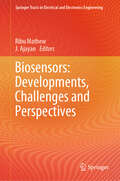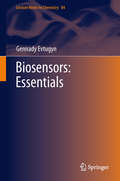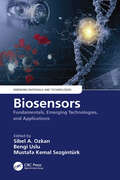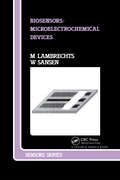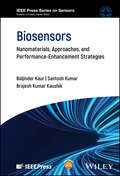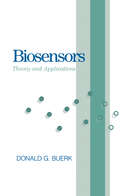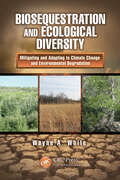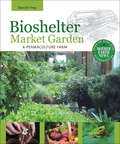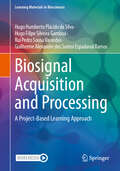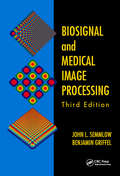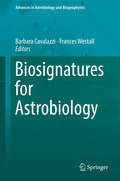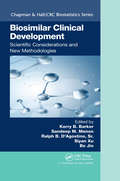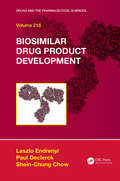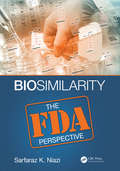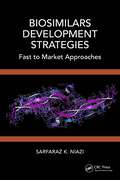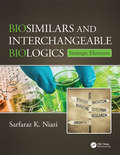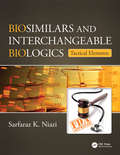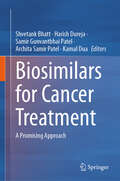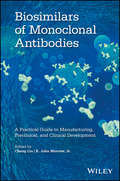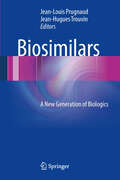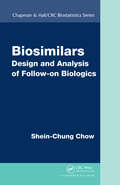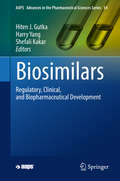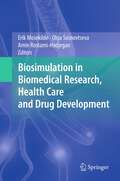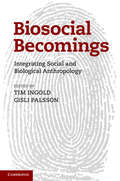- Table View
- List View
Biosensors: Developments, Challenges and Perspectives (Springer Tracts in Electrical and Electronics Engineering)
by J. Ajayan Ribu MathewThis book equips its readers with fundamental concepts and a comprehensive understanding of the principle and functionality of biosensors. This book focuses on various biosensor technologies like field effect transistor (FET), plasmonics, bioresorbable biosensors, electro-chemical biosensors, etc., and their applications. The book also covers the reliability aspects and challenges in biosensor development that are a major cause of erroneous calibration and even failure. The book also features the concept of bio receptors, immobilization techniques, target-receptor interactions, surface energy changes, sensitivity, selectivity, etc. This would be an ideal reference for researchers and scholars studying biosensors realized with various material sets and technologies including state-of-the-art modern materials and innovative techniques.
Biosensors: Essentials (Lecture Notes in Chemistry #84)
by Gennady EvtugynToday, biosensors are broadly applied in research, clinical diagnosis and monitoring, as well as in pharmaceutical, environmental or food analysis. In this work, the author presents the essentials that advanced students and researchers need to know in order to make full use of this technology. This includes a description of biochemical recognition elements, such as enzymes, antibodies, aptamers or even whole cells. Various signal transducers such as electrochemical and optical transducers, luminescence devices and advanced techniques such as quartz crystal microbalances and MEMS systems are covered as well. Current applications are introduced through various case studies, rounded out by a forward-looking chapter on the prospects for biosensor development offered by nanotechnology, lab-on-a-chip, and biomimetic systems.
Biosensors: Fundamentals, Emerging Technologies, and Applications (Emerging Materials and Technologies)
by Sibel A. Ozkan Bengi Uslu Mustafa Kemal SezgintürkBiosensors: Fundamentals, Emerging Technologies, and Applications provides insight into the sensing applications of different types of biosensors relating to environmental pollutants, microbiological analysis, and healthcare. It describes state-of-the-art research in biosensors, point of care testing, potential applications, as well as future prospects for biosensors. This book: Presents the essentials that readers need to know to make full use of biosensor technology Discusses recent perspectives on optical and electrochemical biosensors Details biosensor types for medical applications Teaches how to use enzymes for biological recognition in biomarker assays Proposes innovations in wearable and smart biosensors This book is aimed at advanced students, researchers, and academics across a broad interdisciplinary field including biochemical, pharmaceutical, and environmental engineering as well as materials science, analytical chemistry, and biosciences.
Biosensors: Microelectrochemical Devices
by M Lambrechts W SansenBiosensors are analytical devices that combine a biologically sensitive element with a physical or chemical transducer to selectively and quantitatively detect the presence of specific compounds. Balancing basics, principles, and case studies, Biosensors: Microelectrochemical Devices covers the theory and applications of one class of biosensor-microelectrochemical devices. The book clearly explains microelectronic techniques used to produce these cheap, fast reacting, and disposable sensors with the aid of helpful diagrams and tables. Researchers and postgraduates active in the field of chemical sensors, analytical chemistry, or microelectronics will find this an invaluable reference.
Biosensors: Nanomaterials, Approaches, and Performance-Enhancement Strategies (IEEE Press Series on Sensors)
by Brajesh Kumar Kaushik Santosh Kumar Baljinder KaurComprehensive resource covering new technologies, materials, strategies, and recent advancements in the field of biosensing Biosensors summarizes cutting-edge technologies in biosensing, including gene editing (known as Clustered Regularly Interspaced Short Palindromic Repeat or CRISPR), quorum sensing utilizing inter and intra cell signals, two-dimensional (2D) materials and aptamer-mediated sensor designs, and more, with additional coverage of the latest materials, strategies, and advancements made in the field. Chapters are categorized on the basis of various bio-recognition elements that include aptamer, nucleic acid, enzymes, antibodies, bacteriophages, peptides, and molecular imprinted polymers. Plasmonic, surface-enhanced Raman scattering, colorimetric, fluorescence, electrochemical, magneto and piezo-electric biosensor sensing techniques are also considered. The roles of various nanomaterials, advancement in synthesis, signal enhancement strategies, and new trends for biomedical applications are also described. Current challenges, limitations, and future prospects to developing biosensors for point-of-care and clinical applications are also discussed. Written by three highly qualified authors, Biosensors includes information on: Diverse bio-receptors include nucleic acids, aptamers, enzymes, antibodies, bacteriophages, molecularly imprinted polymers, whole-cell, and techniques of immobilization Different transduction principles using bio-receptors (e.g., optical, electrochemical, piezo-electrical, and SERS) to detect microorganism, toxins, and diseases Nanomaterials synthesis, their role in biosensing, pros and cons of carbon, polymer, metals, metal oxides, and quantum dots-based nanomaterials in medical biosensing applications Biosensors is a comprehensive and complete resource on the subject for researchers and professionals in physics, chemistry, and biomedical science, research communities working in the fields of plasmonics, optics, biosensors, and nano-photonics, and students in related programs of study.
Biosensors: Theory and Applications
by Donald G. BuerkThis introductory text covers in detail the technology and applications of biosensors in their many forms. It provides an extensive survey of the basic principles, functions and applications of different categories of biosensors. The presentation is concise, systematic and well illustrated. Numerous schematics illustrate design and function.This bo
Biosequestration and Ecological Diversity: Mitigating and Adapting to Climate Change and Environmental Degradation (Social Environmental Sustainability)
by Wayne A. WhiteIncreased throughput of carbon-based fossil energy, the destruction of Earth's forests, and other land use changes have resulted in ever higher levels of waste in the form of greenhouse gases-as well as a diminished capacity of the planet to absorb and store those wastes. This means that to avoid catastrophic global warming and maintain the habitab
Bioshelter Market Garden: A Permaculture Farm (Mother Earth News Books for Wiser Living)
by Darrell Frey&“This well-illustrated case study . . . will help students of permaculture, of sustainability, of earth regeneration and of integrated eco-social design.&” —Prof. Declan Kennedy, Chairman, Advisory Board, gaiauniversity.org To ensure food security and restore the health of the planet, we need to move beyond industrial agriculture and return to the practice of small-scale, local farming. The Bioshelter Market Garden: A Permaculture Farm describes the creation of a sustainable food system through a detailed case study of the successful year-round organic market garden and permaculture design at Pennsylvania&’s Three Sisters Farm. At the heart of Three Sisters is its bioshelter—a solar greenhouse which integrates growing facilities, poultry housing, a potting room, storage, kitchen facilities, compost bins, a reference library and classroom area. The Bioshelter Market Garden examines how the bioshelter promotes greater biodiversity and is an energy efficient method of extending crop production through Pennsylvania&’s cold winter months. Both visionary and practical, this fully illustrated book contains a wealth of information on the application of permaculture principles. Some of the topics covered include: Design and management of an intensive market garden farmEnergy systems and bio-thermal resourcesEcological soil management and pest controlWetlands usageSolar greenhouse design and management Whatever your gardening experience and ambitions, this comprehensive manual is sure to inform and inspire.&“Darrell Frey&’s inspirational book gives you all you need to know to create an energy-saving, food-producing bioshelter . . . [It] covers everything you need to understand, build, or simply admire these important tools for sustainability.&” —Toby Hemenway, author of Gaia&’s Garden
Biosignal Acquisition and Processing: A Project-Based Learning Approach (Learning Materials in Biosciences)
by Hugo Humberto da Silva Hugo Filipe Silveira Gamboa Rui Pedro Sousa Varandas Guilherme Alexandre dos Santos Espadanal RamosThis textbook provides an introduction to common concepts in biosignal acquisition and processing, rooted in a Project-Based Learning (PBL). A series of exercises and corresponding solutions is described, with a focus on common problems that new entrants encounter in the undergraduate and graduate curriculums in biomedical engineering, psychophysiology, human-computer interaction, physiotherapy, and others developing work in the boundary between biosignal acquisition and other disciplines. Solutions include both hardware and software components, encompassing sensor design, biosignals acquisition using the Arduino and BITalino platforms, Python for signal processing, analysis, and knowledge extraction, including also HTML/CSS/JavaScript for user interface design. All the content is supported with rich graphics, source code, and other useful resources made available to the interested reader. This is an ideal book for undergraduate students and practitioners (across disciplines) who are studying or working in the field of biomedical signal acquisition, processing, and analysis.
Biosignal Processing: Principles and Practices
by Joseph D. Bronzino Donald R. Peterson Hualou LiangWith the rise of advanced computerized data collection systems, monitoring devices, and instrumentation technologies, large and complex datasets accrue as an inevitable part of biomedical enterprise. The availability of these massive amounts of data offers unprecedented opportunities to advance our understanding of underlying biological and physiol
Biosignal and Medical Image Processing
by John L. Semmlow Benjamin GriffelWritten specifically for biomedical engineers, Biosignal and Medical Image Processing, Third Edition provides a complete set of signal and image processing tools, including diagnostic decision-making tools, and classification methods. Thoroughly revised and updated, it supplies important new material on nonlinear methods for describing and classify
Biosignatures for Astrobiology (Advances in Astrobiology and Biogeophysics)
by Barbara Cavalazzi Frances WestallThis book aims at providing a brief but broad overview of biosignatures. The topics addressed range from prebiotic signatures in extraterrestrial materials to the signatures characterising extant life as well as fossilised life, biosignatures related to space, and space flight instrumentation to detect biosignatures either in situ or from orbit. The book ends with philosophical reflections on the implications of life elsewhere. In the 15 chapters written by an interdisciplinary team of experts, it provides both detailed explanations on the nature of biosignatures as well as useful case studies showing how they are used and identified in ancient rocks, for example. One case study addresses the controversial finding of traces of fossil life in a meteorite from Mars. The book will be of interest not only to astrobiologists but also to terrestrial paleontologists as well as any reader interested in the prospects of finding a second example of life on another planet.
Biosimilar Clinical Development: Scientific Considerations and New Methodologies (Chapman & Hall/CRC Biostatistics Series)
by Kerry B. Barker Sandeep M. Menon Siyan Xu Bo Jin Ralph B. D’Agostino Sr.Biosimilars have the potential to change the way we think about, identify, and manage health problems. They are already impacting both clinical research and patient care, and this impact will only grow as our understanding and technologies improve. Written by a team of experienced specialists in clinical development, this book discusses various potential drug development strategies, the design and analysis of pharmacokinetics (PK) studies, and the design and analysis of efficacy studies.
Biosimilar Drug Product Development (Drugs and the Pharmaceutical Sciences)
by Shein-Chung Chow Laszlo Endrenyi Paul Jules DeclerckWhen a biological drug patent expires, alternative biosimilar products are developed. The development of biosimilar products is complicated and involves numerous considerations and steps. The assessment of biosimilarity and interchangeability is also complicated and difficult. Biosimilar Drug Product Development presents current issues for the development of biosimilars and gives detailed reviews of its various stages and contributing factors as well as relevant regulatory pathways and pre- and post-approval issues.
Biosimilarity: The FDA Perspective
by Sarfaraz NiaziSummary: The focus of this book is on how the U.S. FDA will approve biosimilar drugs, as learned from recent approvals by the FDA. Understanding the limitations of the statutory limits and non-inferiority testing are presented as tools to obviate patient trials and minimize testing of immunogenicity. An in-depth scientific, mathematical and statistical view of the tools required to establish biosimilarity of biological drugs of different complexity -- a must for every developer of biosimilars. Features: First comprehensive analysis based on new guidelines and approval packages of several biosimilars Presents the first approach to challenge FDA in reducing or eliminating any testing in patients. Provides a comprehensive understanding of the U.S. statutory requirements vis-a-vis the regulatory guidelines Provides model CQA and Analytical Similarity testing protocols for cytokines and monoclonal antibodies Allow creation of a fast-to-market pathway to develop biosimilars
Biosimilars Development Strategies: Fast to Market Approaches
by Sarfaraz K. NiaziAfter 18 years since the first biosimilar was approved, a lot has changed, from the regulatory guidelines to the stakeholder perceptions about the safety and efficacy of biosimilars. However, the development costs remain high, preventing faster entry into markets with more than 200 choices. Analyzing the regulatory filings of all approved biosimilars in the US and EU, a deep analysis of the scientific principles, and continuous challenges to the regulatory authorities have made it possible to plan the development on a fast track. This book teaches how to cut the current time and cost by more than 70%, based on the author's hands-on experience.Features: Describes the emergence of biosimilars since the first publication of the recombinant engineering patent, as well as a listing of all approved recombinant products, their patent expiry and their adoption across the globe. Provides a better understanding of the safety and efficacy of approved biosimilars. Global approval requires accommodating guidelines and detailed planning to avoid redundancy as well as high costs. The basic expectations of the agencies are presented here. Presents a detailed analysis of all EU and FDA-approved products with a comparative analysis. Renowned author and entrepreneur in the field of drug discovery and production.
Biosimilars and Interchangeable Biologics: Strategic Elements
by Sarfaraz NiaziWhat’s the Deal with Biosimilars? Biosimilars are gaining momentum as new protein therapeutic candidates that can help fill a vital need in the healthcare industry. The biological drugs are produced by recombinant DNA technology that allows for large-scale production and an overall reduction time in costs and development. Part of a two-volume set that covers varying aspects of biosimilars, Biosimilars and Interchangeable Biologics: Strategic Elements explores the strategic planning side of biosimilar drugs and targets issues surrounding biosimilars that are linked to legal matters. This includes principal patents and intellectual property, regulatory pathways, and concerns about affordability on a global scale. It addresses the complexity of biosimilar products, and it discusses the utilization of biosimilars and related biological drugs in expanding world markets. Of specific interest to practitioners, researchers, and scientists in the biopharmaceutical industry, this volume examines the science, technology, finance, legality, ethics, and politics of biosimilar drugs. It considers strategic planning elements that include an overall understanding of the history and the current status of the art and science of biosimilars, and it provides detailed descriptions of the legal, regulatory, and commercial characteristics. The book also presents a global strategy on how to build, take to market, and manage the next generation of biosimilars throughout their life cycle.
Biosimilars and Interchangeable Biologics: Tactical Elements
by Sarfaraz K. NiaziWhat's the Deal with Biosimilars?Biosimilars are gaining momentum as new protein therapeutic candidates that can help fill a vital need in the healthcare industry. The biological drugs are produced by recombinant DNA technology that allows for large-scale production and an overall reduction time in costs and development. Part of a two-volume set th
Biosimilars for Cancer Treatment: A Promising Approach
by Kamal Dua Shvetank Bhatt Harish Dureja Samir Gunvantbhai Patel Archita Samir PatelThe book delves into the role of biosimilars in the field of cancer treatment. It also discusses the application of biosimilars in various cancer types, from colorectal and cervical to prostate, gastric, lung, pancreatic, breast, hepatocellular, ovarian, and blood cancers. It contains chapters that focus on the clinical trials of biosimilars, providing insights into the latest research and developments. This book serves as a valuable resource for clinicians, researchers, and anyone seeking a comprehensive understanding of the intersection between biosimilars and cancer treatment.
Biosimilars of Monoclonal Antibodies: A Practical Guide to Manufacturing, Preclinical, and Clinical Development
by Cheng Liu K. John Morrow Jr.Addressing a significant need by describing the science and process involved to develop biosimilars of monoclonal antibody (mAb) drugs, this book covers all aspects of biosimilar development: preclinical, clinical, regulatory, manufacturing. • Guides readers through the complex landscape involved with developing biosimilar versions of monoclonal antibody (mAb) drugs• Features flow charts, tables, and figures that clearly illustrate processes and makes the book comprehensible and accessible• Includes a review of FDA-approved mAb drugs as a quick reference to facts and useful information• Examines new technologies and strategies for improving biosimilar mAbs
Biosimilars: A New Generation of Biologics
by Jean-Louis Prugnaud Jean-Hugues TrouvinBiologics have revolutionised the treatment of many severe conditions, delivering exceptional clinical results but also producing exceptionally high prices. As patents expire, copies and price competition are expected throughout the world. However, due to the intrinsic heterogeneity and molecular complexity of biologic medicinal products, their copies cannot simply be authorized under the "generic rule" valid for small chemical entities. In response, a dedicated regulation was issued in the European Union. It is based on the concept of "biological medicinal products similar to a biological reference product", or "biosimilars". This book analyses the context of biotechnological production and addresses the European legal framework for biosimilar market approval. It highlights post-market authorisation issues, such as Risk Management Plans and substitution of products, and outlines some other issues, such as cost management and international nomenclature. This book is primarily intended for hospital-based physicians and pharmacists. It will also be a valuable resource for all actors from all countries who want to better understand the emergence of these new medicinal products within the European context.
Biosimilars: Design and Analysis of Follow-on Biologics
by Shein-Chung ChowAs many biological products face losing their patents in the next decade, the pharmaceutical industry needs an abbreviated regulatory pathway for approval of biosimilar drug products, which are cost-effective, follow-on/subsequent versions of the innovator's biologic products. But scientific challenges remain due to the complexity of both the manuf
Biosimilars: Regulatory, Clinical, And Biopharmaceutical Development (AAPS Advances in the Pharmaceutical Sciences Series #34)
by Hiten J. Gutka Harry Yang Shefali KakarThis book provides a comprehensive overview of the biosimilar regulatory framework, the development process and clinical aspects for development of biosimilars. The development path of a biosimilar is just as unique as a development path of a new drug, tailored by the mechanism of action, the quality of the molecule, published information on the reference product, the current competitive environment, the target market and regulatory guidance, and most importantly, the emerging totality of evidence for the proposed biosimilar during development. For the ease of readers, the book comprises of six sections as follows: Section I: Business, Health Economics and Intellectual Property Landscape for Biosimilars Section II: Regulatory Aspects of Development and Approval for Biosimilars Section III: Biopharmaceutical Development and Manufacturing of Biosimilars Section IV: Analytical Similarity Considerations for Biosimilars Section V: Clinical aspects of Biosimilar Development Section VI: Biosimilars- Global Development and Clinical Experience Chapters have been written by one or more experts from academia, industry or regulatory agencies who have been involved with one or more aspects of biosimilar product development. The authors and editors have an expertise in commercialization and pricing of biosimilars, intellectual property considerations for biosimilars, chemistry manufacturing controls (CMC) and analytical development for biosimilars, regulatory and clinical aspects of biosimilar development. Besides the industry practitioners, the book includes several contributions from regulators across the globe.
Biosimulation in Biomedical Research, Health Care and Drug Development
by Olga Sosnovtseva Amin Rostami-Hodjegan Erik MosekildeBiosimulation is an approach to biomedical research and the treatment of patients in which computer modeling goes hand in hand with experimental and clinical work. Constructed models are used to interpret experimental results and to accumulate information from experiment to experiment. This book explains the concepts used in the modeling of biological phenomena and goes on to present a series of well-documented models of the regulation of various genetic, cellular and physiological processes. The way how the use of computer models allows optimization of cancer treatment for individual patients is discussed and models of interacting nerve cells that can be used to design new treatments for patients with Parkinson's disease are explained. Furthermore this volume provides an overview on the use of models in industry, and presents the view of regulatory agencies on the topic.
Biosocial Becomings
by Tim Ingold Gisli PalssonAll human life unfolds within a matrix of relations, which are at once social and biological. Yet the study of humanity has long been divided between often incompatible 'social' and 'biological' approaches. Reaching beyond the dualisms of nature and society and of biology and culture, this volume proposes a unique and integrated view of anthropology and the life sciences. Featuring contributions from leading anthropologists, it explores human life as a process of 'becoming' rather than 'being', and demonstrates that humanity is neither given in the nature of our species nor acquired through culture but forged in the process of life itself. Combining wide-ranging theoretical argument with in-depth discussion of material from recent or ongoing field research, the chapters demonstrate how contemporary anthropology can move forward in tandem with groundbreaking discoveries in the biological sciences.
